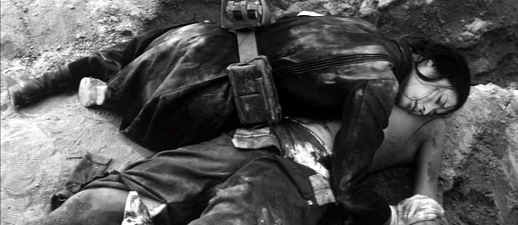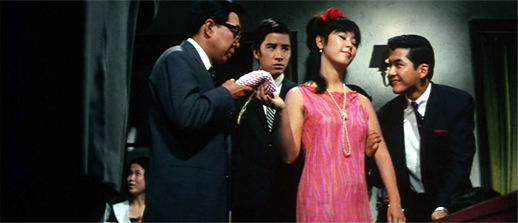Yasuzo Masumura: Sex and Love
The films of Yasuzo Masumura present us with a series of dazzling paradoxes. By his own account, Masumura sought to depict “the universal and essential content of human beings”, he was committed to a rational exposition of human character, and yet he also freely admitted that his films are populated by “lunatics [kyojin] who express their desires without shame or discretion.” He emerged as a critic of melodrama and naturalism in the Japanese cinema, but simultaneously dismissed the decorous restraint of the classical age, elaborating in its place a powerful and destructive eros. His critical eye brought the cupidity of the postwar era into harsh focus, yet he was intrigued with the idea that the arrivistes of high-growth Japan were the face of the future. He distanced himself from the “cult of the image”, yet his films assail us with a striking visual geometry.
A mini-retrospective, running through February 6th at the Kadokawa Cinema in Shinjuku, affords us an opportunity to explore Masumura’s paradoxical vision. The twelve films being shown in “Yasuzo Masumura: Sex and Love” represent his mature style, all but one dating from the last five years of his tenure at Daiei studios (1957-71). While his earlier works are often marked by an acerbic satire of Japanese society, these later films are more overtly concerned with women, individualism, and explorations — often extreme — of eroticism.
Red Angel (Akai Tenshi, 1966) is in this respect exemplary. Set during the second Sino-Japanese war, it follows nurse Sakura Nishi (Ayako Wakao) as she is dispatched to a mobile surgical unit in Tientsin, China. There, Nishi falls in love with Dr. Okabe (Shinsuke Ashida). In his depiction of a war hospital Masumura spares us nothing. Sakura Nishi is the angelic nurse incarnate: prepared to endure everything, she serves the cause of war, even giving herself physically to those who have been destroyed by it. In this selfless intimacy, though, Nishi seems fated to doom those she most wishes to save. She is, as the critic Max Tessier has pointed out, an angel of death. Characteristically, Masumura grants his heroine a strength and conviction that none of the male characters can match. Nishi reminds Okabe that “the life of a sakura is short” but she proves to be indestructible. It is difficult to imagine an erotic war film, but Red Angel is it. This is a savage and unforgettable work, composed of hauntingly perfect images, yet war is not aestheticized as in the case of Marinetti — quite the contrary. While graphic and pitiless, the interest of Red Angel stems not from any particular statement against war, but from its treatment of Nishi as a priestess of eros and death.

This retrospective is dedicated to Ken Ogata who, sadly, passed away last October. An imposing presence known for his roles in Shohei Imamura’s Vengeance is Mine (1979) and The Ballad of Narayama (1983), Ogata’s first leading role was in Masumura’s Sex Check — the Second Sex (1968). Here, Ogata plays Shiro Miyagi, a sprinter with Olympic aspirations whose dreams were shattered by WWII. A broken man, he leads the dissolute life of a gigolo until a chance meeting with a fiery young athlete named Hiroko (Michiyo Yasuda, who also plays Naomi in A Fool’s Love). Realizing that she has talent as a sprinter, Miyagi sees a second chance at Olympic glory in becoming her coach. Following Miyagi’s unconventional, military-style training, Hiroko sets a record for the 100-meter dash, but her greatest hurdle proves to be a “sex check” which all professional athletes must pass. The Second Sex shows the love-hate relationship between athlete and coach as a means to explore a hypothesis about gender, androgyny, and human potential. This is, simply put, an unclassifiable film.
Masumura’s works have a density and economy that belongs to a different age of cinema. In part, this is a consequence of being literary adaptations, ranging from the jun bungaku of Tanizaki (A Fool’s Love) and Kawabata, to popular genre writers such as Ranpo (Blind Beast) and Hugh Callingham Wheeler (Two Wives). Masumura’s talent is clearly in rendering shorter, lesser-known works for the screen, but all are represented in this retrospective. While the adaptation of Kawabata’s Thousand Cranes is only marginally satisfying (likely a studio rush job to immediately capitalize on the author’s reception of the Nobel Prize), a far more compelling film is Lullaby of the Earth (1976). Set in the first decade of the Showa era, this is the story of Orin (Mieko Harada), a half-wild girl from the mountains of Shikoku who is sold into prostitution. Possessing a fearsome telluric power, Orin enters a life-or-death struggle with the owners and denizens of the brothel. Very different from Masumura’s earlier works, this is one of his few independent films, and the only one in his career to explore themes of spiritualism, nature, pilgrimage [junrei], and atonement.

In his quest to show the essential nature of the individual, Masumura developed an idiosyncratic and in some respects highly artificial dramaturgy. Western critics of the Japanese cinema have long discussed a broad tendency towards the theatrical, but Masumura’s films rarely draw direct attention to themselves as such, i.e., they are never mechanically theatrical. Above all, Masumura offers a social vision of postwar Japan, yet we are left with a puzzle of film style: how can we reconcile his films’ abstraction of character, narration, and image with their extreme concreteness of setting, situation, and social conflict?
M. Downing Roberts
M. Downing Roberts


